Question
The function f is defined by \(f(x) = x{{\text{e}}^{2x}}\) .
It can be shown that \({f^{(n)}}(x) = ({2^n}x + n{2^{n – 1}}){{\text{e}}^{2x}}\) for all \(n \in {\mathbb{Z}^ + }\), where \({f^{(n)}}(x)\) represents the \({n^{{\text{th}}}}\) derivative of \(f(x)\) .
(a) By considering \({f^{(n)}}(x){\text{ for }}n = 1{\text{ and }}n = 2\) , show that there is one minimum point P on the graph of f , and find the coordinates of P.
(b) Show that f has a point of inflexion Q at x = −1.
(c) Determine the intervals on the domain of f where f is
(i) concave up;
(ii) concave down.
(d) Sketch f , clearly showing any intercepts, asymptotes and the points P and Q.
(e) Use mathematical induction to prove that \({f^{(n)}}(x) = ({2^n}x + n{2^{n – 1}}){{\text{e}}^{2x}}{\text{ for all }}n \in {\mathbb{Z}^ + },{\text{ where }}{f^{(n)}}{\text{ represents the }}{n^{{\text{th}}}}{\text{ derivative of }}f(x)\) .
Answer/Explanation
Markscheme
(a) \(f'(x) = (1 + 2x){{\text{e}}^{2x}}\) A1
\(f'(x) = 0\) M1
\( \Rightarrow (1 + 2x){{\text{e}}^{2x}} = 0 \Rightarrow x = – \frac{1}{2}\) A1
\(f”(x) = ({2^2}x + 2 \times {2^{2 – 1}}){{\text{e}}^{2x}} = (4x + 4){{\text{e}}^{2x}}\) A1
\(f”\left( { – \frac{1}{2}} \right) = \frac{2}{{\text{e}}}\) A1
\(\frac{2}{{\text{e}}} > 0 \Rightarrow {\text{at }}x = – \frac{1}{2},{\text{ }}f(x){\text{ has a minimum.}}\) R1
\({\text{P}}\left( { – \frac{1}{2}, – \frac{1}{{2{\text{e}}}}} \right)\) A1
[7 marks]
(b) \(f”(x) = 0 \Rightarrow 4x + 4 = 0 \Rightarrow x = – 1\) M1A1
\({\text{Using the }}{{\text{2}}^{{\text{nd}}}}{\text{ derivative }}f”\left( { – \frac{1}{2}} \right) = \frac{2}{{\text{e}}}{\text{ and }}f”( – 2) = – \frac{4}{{{{\text{e}}^4}}},\) M1A1
the sign change indicates a point of inflexion. R1
[5 marks]
(c) (i) f(x) is concave up for \(x > – 1\) . A1
(ii) f(x) is concave down for \(x < – 1\) . A1
[2 marks]
(d)
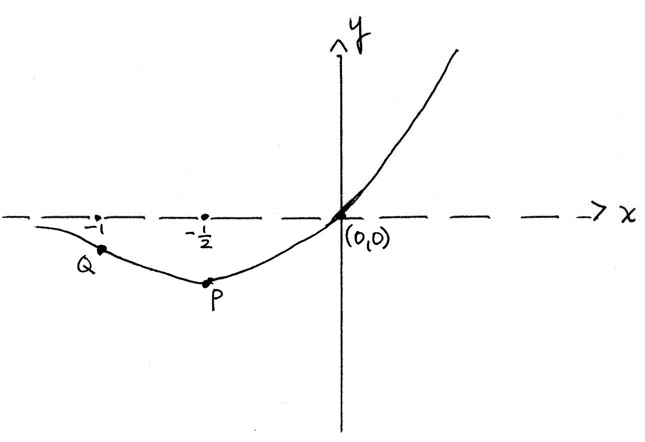 A1A1A1A1
A1A1A1A1
Note: Award A1 for P and Q, with Q above P,
A1 for asymptote at y = 0 ,
A1 for (0, 0) ,
A1 for shape.
[4 marks]
(e) Show true for n = 1 (M1)
\(f'(x) = {{\text{e}}^{2x}} + 2x{{\text{e}}^{2x}}\) A1
\( = {{\text{e}}^{2x}}(1 + 2x) = (2x + {2^0}){{\text{e}}^{2x}}\)
Assume true for \(n = k{\text{ , }}i.e.{\text{ }}{f^{(k)}}x = ({2^k}x + k \times {2^{k – 1}}){{\text{e}}^{2x}}{\text{, }}k \geqslant 1\) M1A1
Consider \(n = k + 1{\text{ , }}i.e.{\text{ an attempt to find }}\frac{{\text{d}}}{{{\text{d}}x}}\left( {{f^k}(x)} \right)\) . M1
\({F^{(k + 1)}}(x) = {2^k}{{\text{e}}^{2x}} + 2{{\text{e}}^{2x}}({2^k}x + k \times {2^{k – 1}})\) A1
\( = \left( {{2^k} + 2({2^k}x + k \times {2^{k – 1}})} \right){{\text{e}}^{2x}}\)
\( = (2 \times {2^k}x + {2^k} + k \times 2 \times {2^{k – 1}}){{\text{e}}^{2x}}\)
\( = ({2^{k + 1}}x + {2^k} + k \times {2^k}){{\text{e}}^{2x}}\) A1
\( = \left( {{2^{k + 1}}x + \left( {k + 1} \right){2^k}} \right){{\text{e}}^{2x}}\) A1
P(n) is true for \(k \Rightarrow P(n)\) is true for k + 1, and since true for n = 1, result proved by mathematical induction \(\forall n \in {\mathbb{Z}^ + }\)
Note: Only award R1 if a reasonable attempt is made to prove the \({(k + 1)^{{\text{th}}}}\) step.
[9 marks]
Total [27 marks]
Examiners report
This was the most accessible question in section B for these candidates. A majority of candidates produced partially correct answers to part (a), but a significant number struggled with demonstrating that the point is a minimum, despite the hint being given in the question. Part (b) started quite successfully but many students were unable to prove it is a point of inflexion or, more commonly, did not attempt to justify it. Correct answers were often seen for part (c). Part (d) was dependent on the successful completion of the first three parts. If candidates made errors in earlier parts, this often became obvious when they came to sketch the curve. However, few candidates realised that this part was a good way of checking that the above answers were at least consistent. The quality of curve sketching was rather weak overall, with candidates not marking points appropriately and not making features such as asymptotes clear. It is not possible to tell to what extent this was an effect of candidates not having a calculator, but it should be noted that asking students to sketch curves without a calculator will continue to appear on non-calculator papers. In part (e) the basic idea of proof by induction had clearly been taught with a significant majority of students understanding this. However, many candidates did not understand that they had to differentiate again to find the result for (k + 1) .
Question
Consider \(f(x) = \frac{{{x^2} – 5x + 4}}{{{x^2} + 5x + 4}}\).
(a) Find the equations of all asymptotes of the graph of f.
(b) Find the coordinates of the points where the graph of f meets the x and y axes.
(c) Find the coordinates of
(i) the maximum point and justify your answer;
(ii) the minimum point and justify your answer.
(d) Sketch the graph of f, clearly showing all the features found above.
(e) Hence, write down the number of points of inflexion of the graph of f.
Answer/Explanation
Markscheme
(a) \({x^2} + 5x + 4 = 0 \Rightarrow x = – 1{\text{ or }}x = – 4\) (M1)
so vertical asymptotes are x = – 1 and x = – 4 A1
as \(x \to \infty \) then \(y \to 1\) so horizontal asymptote is y = 1 (M1)A1
[4 marks]
(b) \({x^2} – 5x + 4 = 0 \Rightarrow x = 1{\text{ or }}x = 4\) A1
\(x = 0 \Rightarrow y = 1\) A1
so intercepts are (1, 0), (4, 0) and (0,1)
[2 marks]
(c) (i) \(f'(x) = \frac{{({x^2} + 5x + 4)(2x – 5) – ({x^2} – 5x + 4)(2x + 5)}}{{{{({x^2} + 5x + 4)}^2}}}\) M1A1A1
\( = \frac{{10{x^2} – 40}}{{{{({x^2} + 5x + 4)}^2}}}\,\,\,\,\,\left( { = \frac{{10(x – 2)(x + 2)}}{{{{({x^2} + 5x + 4)}^2}}}} \right)\) A1
\(f'(x) = 0 \Rightarrow x = \pm 2\) M1
so the points under consideration are (–2, –9) and \(\left( {2, – \frac{1}{9}} \right)\) A1A1
looking at the sign either side of the points (or attempt to find \(f”(x)\)) M1
e.g. if \(x = – {2^ – }\) then \((x – 2)(x + 2) > 0\) and if \(x = – {2^ + }\) then \((x – 2)(x + 2) < 0\),
therefore (–2, –9) is a maximum A1
(ii) e.g. if \(x = {2^ – }\) then \((x – 2)(x + 2) < 0\) and if \(x = {2^ + }\) then \((x – 2)(x + 2) > 0\),
therefore \(\left( {2, – \frac{1}{9}} \right)\) is a minimum A1
Note: Candidates may find the minimum first.
[10 marks]
(d)
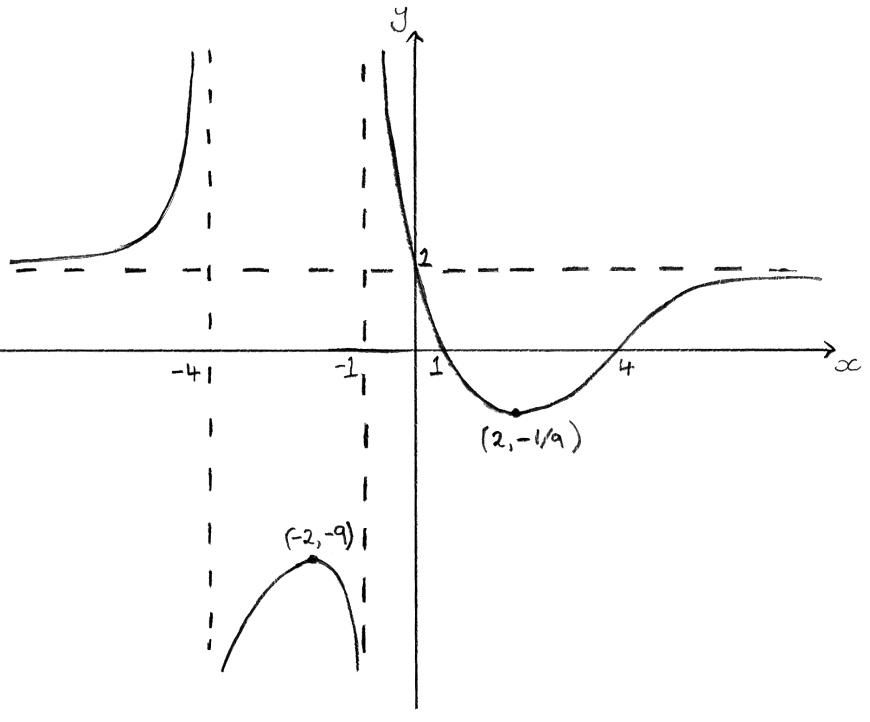 A3
A3
Note: Award A1 for each branch consistent with and including the features found in previous parts.
[3 marks]
(e) one A1
[1 mark]
Total [20 marks]
Examiners report
This was the most successfully answered question in part B, in particular parts (a), (b) and (c). In part (a) the horizontal asymptote was often missing (or x = 4, x = 1 given). Part (b) was well done. Use of the quotient rule was well done in part (c) and many simplified correctly. There was knowledge of max/min and how to justify their answer, usually with a sign diagram but also with the second derivative. A common misconception was that, as \( – 9 < – \frac{1}{9}\), the minimum is at (–2, –9). In part (d) many candidates were unable to sketch the graph consistent with the main features that they had determined before. Very few candidates answered part (e) correctly.
Question
Consider the function \(f(x) = \frac{{\ln x}}{x}\) , \(0 < x < {{\text{e}}^2}\) .
(i) Solve the equation \(f'(x) = 0\) .
(ii) Hence show the graph of \(f\) has a local maximum.
(iii) Write down the range of the function \(f\) .
Show that there is a point of inflexion on the graph and determine its coordinates.
Sketch the graph of \(y = f(x)\) , indicating clearly the asymptote, x-intercept and the local maximum.
Now consider the functions \(g(x) = \frac{{\ln \left| x \right|}}{x}\) and \(h(x) = \frac{{\ln \left| x \right|}}{{\left| x \right|}}\) , where \(0 < x < {{\text{e}}^2}\) .
(i) Sketch the graph of \(y = g(x)\) .
(ii) Write down the range of \(g\) .
(iii) Find the values of \(x\) such that \(h(x) > g(x)\) .
Answer/Explanation
Markscheme
(i) \(f'(x) = \frac{{x\frac{1}{x} – \ln x}}{{{x^2}}}\) M1A1
\( = \frac{{1 – \ln x}}{{{x^2}}}\)
so \(f'(x) = 0\) when \(\ln x = 1\), i.e. \(x = {\text{e}}\) A1
(ii) \(f'(x) > 0\) when \(x < {\text{e}}\) and \(f'(x) < 0\) when \(x > {\text{e}}\) R1
hence local maximum AG
Note: Accept argument using correct second derivative.
(iii) \(y \leqslant \frac{1}{{\text{e}}}\) A1
[5 marks]
\(f”(x) = \frac{{{x^2}\frac{{ – 1}}{x} – \left( {1 – \ln x} \right)2x}}{{{x^4}}}\) M1
\( = \frac{{ – x – 2x + 2x\ln x}}{{{x^4}}}\)
\( = \frac{{ – 3 + 2\ln x}}{{{x^3}}}\) A1
Note: May be seen in part (a).
\(f”(x) = 0\) (M1)
\({ – 3 + 2\ln x = 0}\)
\(x = {{\text{e}}^{\frac{3}{2}}}\)
since \(f”(x) < 0\) when \(x < {{\text{e}}^{\frac{3}{2}}}\) and \(f”(x) > 0\) when \(x > {{\text{e}}^{\frac{3}{2}}}\) R1
then point of inflexion \(\left( {{{\text{e}}^{\frac{3}{2}}},\frac{3}{{2{{\text{e}}^{\frac{3}{2}}}}}} \right)\) A1
[5 marks]
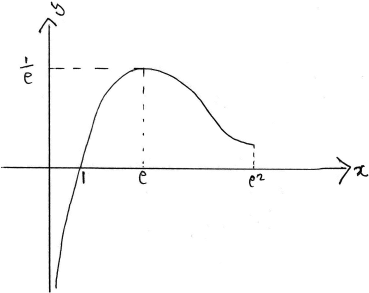 A1A1A1
A1A1A1
Note: Award A1 for the maximum and intercept, A1 for a vertical asymptote and A1 for shape (including turning concave up).
[3 marks]
(i)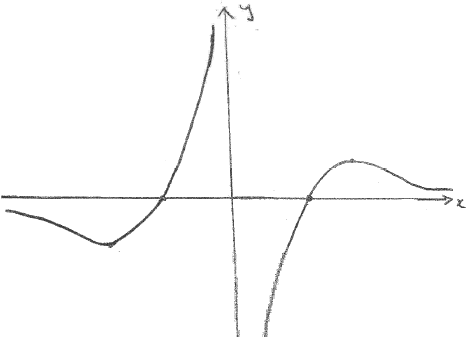 A1A1
A1A1
Note: Award A1 for each correct branch.
(ii) all real values A1
(iii)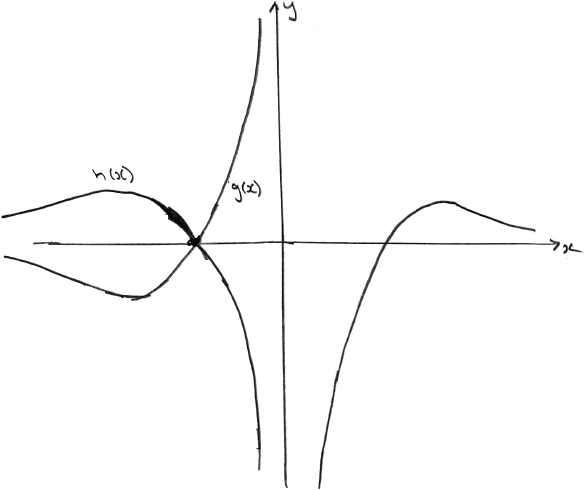 (M1)(A1)
(M1)(A1)
Note: Award (M1)(A1) for sketching the graph of h, ignoring any graph of g.
\( – {{\text{e}}^2} < x < – 1\) (accept \(x < – 1\) ) A1
[6 marks]
Examiners report
Most candidates attempted parts (a), (b) and (c) and scored well, although many did not gain the reasoning marks for the justification of the existence of local maximum and inflexion point. The graph sketching was poorly done. A wide selection of range shapes were seen, in some cases showing little understanding of the relation between the derivatives of the function and its graph and difficulties with transformation of graphs. In some cases candidates sketched graphs consistent with their previous calculations but failed to label them properly.
Most candidates attempted parts (a), (b) and (c) and scored well, although many did not gain the reasoning marks for the justification of the existence of local maximum and inflexion point. The graph sketching was poorly done. A wide selection of range shapes were seen, in some cases showing little understanding of the relation between the derivatives of the function and its graph and difficulties with transformation of graphs. In some cases candidates sketched graphs consistent with their previous calculations but failed to label them properly.
Most candidates attempted parts (a), (b) and (c) and scored well, although many did not gain the reasoning marks for the justification of the existence of local maximum and inflexion point. The graph sketching was poorly done. A wide selection of range shapes were seen, in some cases showing little understanding of the relation between the derivatives of the function and its graph and difficulties with transformation of graphs. In some cases candidates sketched graphs consistent with their previous calculations but failed to label them properly.
Most candidates attempted parts (a), (b) and (c) and scored well, although many did not gain the reasoning marks for the justification of the existence of local maximum and inflexion point. The graph sketching was poorly done. A wide selection of range shapes were seen, in some cases showing little understanding of the relation between the derivatives of the function and its graph and difficulties with transformation of graphs. In some cases candidates sketched graphs consistent with their previous calculations but failed to label them properly.
Question
Let \(f(x) = \sqrt {\frac{x}{{1 – x}}} ,{\text{ }}0 < x < 1\).
Show that \(f'(x) = \frac{1}{2}{x^{ – \frac{1}{2}}}{(1 – x)^{ – \frac{3}{2}}}\) and deduce that f is an increasing function.
Show that the curve \(y = f(x)\) has one point of inflexion, and find its coordinates.
Use the substitution \(x = {\sin ^2}\theta \) to show that \(\int {f(x){\text{d}}x} = \arcsin \sqrt x – \sqrt {x – {x^2}} + c\) .
Answer/Explanation
Markscheme
EITHER
derivative of \(\frac{x}{{1 – x}}\) is \(\frac{{(1 – x) – x( – 1)}}{{{{(1 – x)}^2}}}\) M1A1
\(f'(x) = \frac{1}{2}{\left( {\frac{x}{{1 – x}}} \right)^{ – \frac{1}{2}}}\frac{1}{{{{(1 – x)}^2}}}\) M1A1
\( = \frac{1}{2}{x^{ – \frac{1}{2}}}{(1 – x)^{ – \frac{3}{2}}}\) AG
\(f'(x) > 0\) (for all \(0 < x < 1\)) so the function is increasing R1
OR
\(f(x) = \frac{{{x^{\frac{1}{2}}}}}{{{{(1 – x)}^{\frac{1}{2}}}}}\)
\(f'(x) = \frac{{{{(1 – x)}^{\frac{1}{2}}}\left( {\frac{1}{2}{x^{ – \frac{1}{2}}}} \right) – \frac{1}{2}{x^{\frac{1}{2}}}{{(1 – x)}^{ – \frac{1}{2}}}( – 1)}}{{1 – x}}\) M1A1
\( = \frac{1}{2}{x^{ – \frac{1}{2}}}{(1 – x)^{ – \frac{1}{2}}} + \frac{1}{2}{x^{\frac{1}{2}}}{(1 – x)^{ – \frac{3}{2}}}\) A1
\( = \frac{1}{2}{x^{ – \frac{1}{2}}}{(1 – x)^{ – \frac{3}{2}}}[1 – x + x]\) M1
\( = \frac{1}{2}{x^{ – \frac{1}{2}}}{(1 – x)^{ – \frac{3}{2}}}\) AG
\(f'(x) > 0\) (for all \(0 < x < 1\)) so the function is increasing R1
[5 marks]
\(f'(x) = \frac{1}{2}{x^{ – \frac{1}{2}}}{(1 – x)^{ – \frac{3}{2}}}\)
\( \Rightarrow f”(x) = -\frac{1}{4}{x^{ – \frac{3}{2}}}{(1 – x)^{ – \frac{3}{2}}} + \frac{3}{4}{x^{ – \frac{1}{2}}}{(1 – x)^{ – \frac{5}{2}}}\) M1A1
\( = -\frac{1}{4}{x^{ – \frac{3}{2}}}{(1 – x)^{ – \frac{5}{2}}}[1 – 4x]\)
\(f”(x) = 0 \Rightarrow x = \frac{1}{4}\) M1A1
\(f”(x)\) changes sign at \(x = \frac{1}{4}\) hence there is a point of inflexion R1
\(x = \frac{1}{4} \Rightarrow y = \frac{1}{{\sqrt 3 }}\) A1
the coordinates are \(\left( {\frac{1}{4},\frac{1}{{\sqrt 3 }}} \right)\)
[6 marks]
\(x = {\sin ^2}\theta \Rightarrow \frac{{{\text{d}}x}}{{{\text{d}}\theta }} = 2\sin \theta \cos \theta \) M1A1
\(\int {\sqrt {\frac{x}{{1 – x}}} {\text{d}}x = \int {\sqrt {\frac{{{{\sin }^2}\theta }}{{1 – {{\sin }^2}\theta }}} 2\sin \theta \cos \theta {\text{d}}\theta } } \) M1A1
\( = \int {2{{\sin }^2}\theta {\text{d}}\theta } \) A1
\( = \int {1 – \cos 2\theta } {\text{d}}\theta \) M1A1
\( = \theta – \frac{1}{2}\sin 2\theta + c\) A1
\(\theta = \arcsin \sqrt x \) A1
\(\frac{1}{2}\sin 2\theta = \sin \theta \cos \theta = \sqrt x \sqrt {1 – x} = \sqrt {x – {x^2}} \) M1A1
hence \(\int {\sqrt {\frac{x}{{1 – x}}} {\text{d}}x = \arcsin \sqrt x } – \sqrt {x – {x^2}} + c\) AG
[11 marks]
Examiners report
Part (a) was generally well done, although few candidates made the final deduction asked for. Those that lost other marks in this part were generally due to mistakes in algebraic manipulation. In part (b) whilst many students found the second derivative and set it equal to zero, few then confirmed that it was a point of inflexion. There were several good attempts for part (c), even though there were various points throughout the question that provided stopping points for other candidates.
Part (a) was generally well done, although few candidates made the final deduction asked for. Those that lost other marks in this part were generally due to mistakes in algebraic manipulation. In part (b) whilst many students found the second derivative and set it equal to zero, few then confirmed that it was a point of inflexion. There were several good attempts for part (c), even though there were various points throughout the question that provided stopping points for other candidates.
Part (a) was generally well done, although few candidates made the final deduction asked for. Those that lost other marks in this part were generally due to mistakes in algebraic manipulation. In part (b) whilst many students found the second derivative and set it equal to zero, few then confirmed that it was a point of inflexion. There were several good attempts for part (c), even though there were various points throughout the question that provided stopping points for other candidates.
Question
The diagram shows the graph of the function defined by \(y = x{(\ln x)^2}{\text{ for }}x > 0\) .
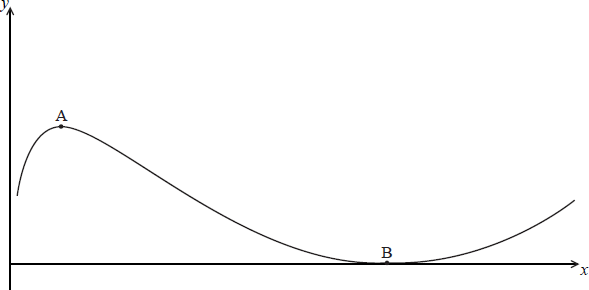
The function has a local maximum at the point A and a local minimum at the point B.
Find the coordinates of the points A and B.
Given that the graph of the function has exactly one point of inflexion, find its coordinates.
Answer/Explanation
Markscheme
\(f'(x) = {(\ln x)^2} + \frac{{2x\ln x}}{x}\left( { = {{(\ln x)}^2} + 2\ln x = \ln x(\ln x + 2)} \right)\) M1A1
\(f'(x) = 0{\text{ }}( \Rightarrow x = 1,{\text{ }}x = {e^{ – 2}})\) M1
Note: Award M1 for an attempt to solve \(f'(x) = 0\).
\(A({e^{ – 2}},\,4{e^{ – 2}})\) and B(1, 0) A1A1
Note: The final A1 is independent of prior working.
[5 marks]
\(f”(x) = \frac{2}{x}(\ln x + 1)\) A1
\(f”(x) = 0{\text{ }}\left( { \Rightarrow x = {e^{ – 1}}} \right)\) (M1)
inflexion point \(({e^{ – 1}},{\text{ }}{e^{ – 1}})\) A1
Note: M1 for attempt to solve \(f”(x) = 0\).
[3 marks]
Examiners report
This was answered very well. Candidates are very familiar with this type of question. Some lost a couple of marks by failing to find their final y coordinates, though only the weakest struggled with differentiation and so made little progress.
This was answered very well. Candidates are very familiar with this type of question. Some lost a couple of marks by failing to find their final y coordinates, though only the weakest struggled with differentiation and so made little progress.
Question
Consider the function \(f(x) = \frac{{\ln x}}{x},{\text{ }}x > 0\).
The sketch below shows the graph of \(y = {\text{ }}f(x)\) and its tangent at a point A.
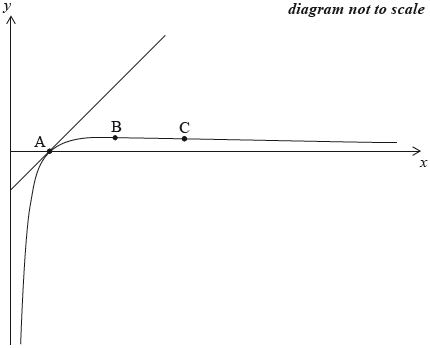
Show that \(f'(x) = \frac{{1 – \ln x}}{{{x^2}}}\).
Find the coordinates of B, at which the curve reaches its maximum value.
Find the coordinates of C, the point of inflexion on the curve.
The graph of \(y = {\text{ }}f(x)\) crosses the \(x\)-axis at the point A.
Find the equation of the tangent to the graph of \(f\) at the point A.
The graph of \(y = {\text{ }}f(x)\) crosses the \(x\)-axis at the point A.
Find the area enclosed by the curve \(y = f(x)\), the tangent at A, and the line \(x = {\text{e}}\).
Answer/Explanation
Markscheme
\(f'(x) = \frac{{x \times \frac{1}{x} – \ln x}}{{{x^2}}}\) M1A1
\( = \frac{{1 – \ln x}}{{{x^2}}}\) AG
[2 marks]
\(\frac{{1 – \ln x}}{{{x^2}}} = 0\) has solution \(x = {\text{e}}\) M1A1
\(y = \frac{1}{{\text{e}}}\) A1
hence maximum at the point \(\left( {{\text{e, }}\frac{1}{{\text{e}}}} \right)\)
[3 marks]
\(f”(x) = \frac{{{x^2}\left( { – \frac{1}{x}} \right) – 2x(1 – \ln x)}}{{{x^4}}}\) M1A1
\( = \frac{{2\ln x – 3}}{{{x^3}}}\)
Note: The M1A1 should be awarded if the correct working appears in part (b).
point of inflexion where \(f”(x) = 0\) M1
so \(x = {{\text{e}}^{\frac{3}{2}}},{\text{ }}y = \frac{3}{2}{{\text{e}}^{\frac{{ – 3}}{2}}}\) A1A1
C has coordinates \(\left( {{{\text{e}}^{\frac{3}{2}}},{\text{ }}\frac{3}{2}{{\text{e}}^{\frac{{ – 3}}{2}}}} \right)\)
[5 marks]
\(f(1) = 0\) A1
\(f'(1) = 1\) (A1)
\(y = x + c\) (M1)
through (1, 0)
equation is \(y = x – 1\) A1
[4 marks]
METHOD 1
area \( = \int_1^{\text{e}} {x – 1 – \frac{{\ln x}}{x}{\text{d}}x} \) M1A1A1
Note: Award M1 for integration of difference between line and curve, A1 for correct limits, A1 for correct expressions in either order.
\(\int {\frac{{\ln x}}{x}{\text{d}}x = \frac{{{{(\ln x)}^2}}}{2}} ( + c)\) (M1)A1
\(\int {(x – 1){\text{d}}x = \frac{{{x^2}}}{2} – x( + c)} \) A1
\( = \left[ {\frac{1}{2}{x^2} – x – \frac{1}{2}{{(\ln x)}^2}} \right]_1^{\text{e}}\)
\( = \left( {\frac{1}{2}{{\text{e}}^2} – {\text{e}} – \frac{1}{2}} \right) – \left( {\frac{1}{2} – 1} \right)\)
\( = \frac{1}{2}{{\text{e}}^2} – {\text{e}}\) A1
METHOD 2
area = area of triangle \( – \int_1^e {\frac{{\ln x}}{x}{\text{d}}x} \) M1A1
Note: A1 is for correct integral with limits and is dependent on the M1.
\(\int {\frac{{\ln x}}{x}{\text{d}}x = \frac{{{{(\ln x)}^2}}}{2}( + c)} \) (M1)A1
area of triangle \( = \frac{1}{2}(e – 1)(e – 1)\) M1A1
\(\frac{1}{2}(e – 1)(e – 1) – \left( {\frac{1}{2}} \right) = \frac{1}{2}{{\text{e}}^2} – {\text{e}}\) A1
[7 marks]
Examiners report
[N/A]
[N/A]
[N/A]
[N/A]
[N/A]
Question
The graph of the function \(f(x) = \frac{{x + 1}}{{{x^2} + 1}}\) is shown below.
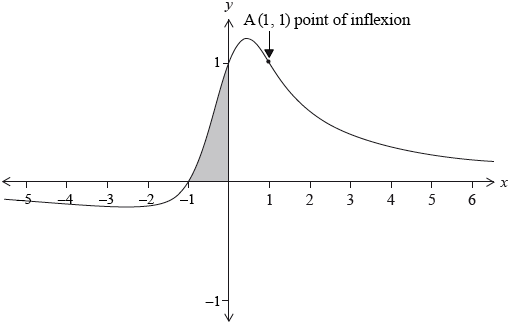
The point (1, 1) is a point of inflexion. There are two other points of inflexion.
Find \(f'(x)\).
Hence find the \(x\)-coordinates of the points where the gradient of the graph of \(f\) is zero.
Find \(f”(x)\) expressing your answer in the form \(\frac{{p(x)}}{{{{({x^2} + 1)}^3}}}\), where \(p(x)\) is a polynomial of degree 3.
Find the \(x\)-coordinates of the other two points of inflexion.
Find the area of the shaded region. Express your answer in the form \(\frac{\pi }{a} – \ln \sqrt b \), where \(a\) and \(b\) are integers.
Answer/Explanation
Answer/Explanation
Markscheme
(a) \(f'(x) = \frac{{\left( {{x^2} + 1} \right) – 2x(x + 1)}}{{{{\left( {{x^2} + 1} \right)}^2}}}{\text{ }}\left( { = \frac{{ – {x^2} – 2x + 1}}{{{{\left( {{x^2} + 1} \right)}^2}}}} \right)\) M1A1
[2 marks]
\(\frac{{ – {x^2} – 2x + 1}}{{{{\left( {{x^2} + 1} \right)}^2}}} = 0\)
\(x = – 1 \pm \sqrt 2 \) A1
[1 mark]
\(f”(x) = \frac{{( – 2x – 2){{\left( {{x^2} + 1} \right)}^2} – 2(2x)\left( {{x^2} + 1} \right)\left( { – {x^2} – 2x + 1} \right)}}{{{{\left( {{x^2} + 1} \right)}^4}}}\) A1A1
Note: Award A1 for \(( – 2x – 2){\left( {{x^2} + 1} \right)^2}\) or equivalent.
Note: Award A1 for \( – 2(2x)\left( {{x^2} + 1} \right)\left( { – {x^2} – 2x + 1} \right)\) or equivalent.
\( = \frac{{( – 2x – 2)\left( {{x^2} + 1} \right) – 4x\left( { – {x^2} – 2x + 1} \right)}}{{{{\left( {{x^2} + 1} \right)}^3}}}\)
\( = \frac{{2{x^3} + 6{x^2} – 6x – 2}}{{{{\left( {{x^2} + 1} \right)}^3}}}\) A1
\(\left( { = \frac{{2\left( {{x^3} + 3{x^2} – 3x – 1} \right)}}{{{{\left( {{x^2} + 1} \right)}^3}}}} \right)\)
[3 marks]
recognition that \((x – 1)\) is a factor (R1)
\((x – 1)\left( {{x^2} + bx + c} \right) = \left( {{x^3} + 3{x^2} – 3x – 1} \right)\) M1
\( \Rightarrow {x^2} + 4x + 1 = 0\) A1
\(x = – 2 \pm \sqrt 3 \) A1
Note: Allow long division / synthetic division.
[4 marks]
\(\int_{ – 1}^0 {\frac{{x + 1}}{{{x^2} + 1}}{\text{d}}x} \) M1
\(\int {\frac{{x + 1}}{{{x^2} + 1}}{\text{d}}x = \int {\frac{x}{{{x^2} + 1}}{\text{d}}x + \int {\frac{1}{{{x^2} + 1}}{\text{d}}x} } } \) M1
\( = \frac{1}{2}\ln \left( {{x^2} + 1} \right) + \arctan (x)\) A1A1
\( = \left[ {\frac{1}{2}\ln \left( {{x^2} + 1} \right) + \arctan (x)} \right]_{ – 1}^0 = \frac{1}{2}\ln 1 + \arctan 0 – \frac{1}{2}\ln 2 – \arctan ( – 1)\) M1
\( = \frac{\pi }{4} – \ln \sqrt 2 \) A1
[6 marks]
Examiners report
[N/A]
[N/A]
[N/A]
[N/A]
[N/A]
Question
Let \(y(x) = x{e^{3x}},{\text{ }}x \in \mathbb{R}\).
Find \(\frac{{{\text{d}}y}}{{{\text{d}}x}}\).
Prove by induction that \(\frac{{{{\text{d}}^n}y}}{{{\text{d}}{x^n}}} = n{3^{n – 1}}{{\text{e}}^{3x}} + x{3^n}{{\text{e}}^{3x}}\) for \(n \in {\mathbb{Z}^ + }\).
Find the coordinates of any local maximum and minimum points on the graph of \(y(x)\).
Justify whether any such point is a maximum or a minimum.
Find the coordinates of any points of inflexion on the graph of \(y(x)\). Justify whether any such point is a point of inflexion.
Hence sketch the graph of \(y(x)\), indicating clearly the points found in parts (c) and (d) and any intercepts with the axes.
Answer/Explanation
Markscheme
\(\frac{{{\text{d}}y}}{{{\text{d}}x}} = 1 \times {{\text{e}}^{3x}} + x \times 3{{\text{e}}^{3x}} = ({{\text{e}}^{3x}} + 3x{{\text{e}}^{3x}})\) M1A1
[2 marks]
let \(P(n)\) be the statement \(\frac{{{{\text{d}}^n}y}}{{{\text{d}}{x^n}}} = n{3^{n – 1}}{{\text{e}}^{3x}} + x{3^n}{{\text{e}}^{3x}}\)
prove for \(n = 1\) M1
\(LHS\) of \(P(1)\) is \(\frac{{{\text{d}}y}}{{{\text{d}}x}}\) which is \(1 \times {{\text{e}}^{3x}} + x \times 3{{\text{e}}^{3x}}\) and \(RHS\) is \({3^0}{{\text{e}}^{3x}} + x{3^1}{{\text{e}}^{3x}}\) R1
as \({\text{LHS}} = {\text{RHS, }}P(1)\) is true
assume \(P(k)\) is true and attempt to prove \(P(k + 1)\) is true M1
assuming \(\frac{{{{\text{d}}^k}y}}{{{\text{d}}{x^k}}} = k{3^{k – 1}}{{\text{e}}^{3x}} + x{3^k}{{\text{e}}^{3x}}\)
\(\frac{{{{\text{d}}^{k + 1}}y}}{{{\text{d}}{x^{k + 1}}}} = \frac{{\text{d}}}{{{\text{d}}x}}\left( {\frac{{{{\text{d}}^k}y}}{{{\text{d}}{x^k}}}} \right)\) (M1)
\( = k{3^{k – 1}} \times 3{{\text{e}}^{3x}} + 1 \times {3^k}{{\text{e}}^{3x}} + x{3^k} \times 3{{\text{e}}^{3x}}\) A1
\( = (k + 1){3^k}{{\text{e}}^{3x}} + x{3^{k + 1}}{{\text{e}}^{3x}}\;\;\;\)(as required) A1
Note: Can award the A marks independent of the M marks
since \(P(1)\) is true and \(P(k)\) is true \( \Rightarrow P(k + 1)\) is true
then (by \(PMI\)), \(P(n)\) is true \((\forall n \in {\mathbb{Z}^ + })\) R1
Note: To gain last R1 at least four of the above marks must have been gained.
[7 marks]
\({{\text{e}}^{3x}} + x \times 3{{\text{e}}^{3x}} = 0 \Rightarrow 1 + 3x = 0 \Rightarrow x = – \frac{1}{3}\) M1A1
point is \(\left( { – \frac{1}{3},{\text{ }} – \frac{1}{{3{\text{e}}}}} \right)\) A1
EITHER
\(\frac{{{{\text{d}}^2}y}}{{{\text{d}}{x^2}}} = 2 \times 3{{\text{e}}^{3x}} + x \times {3^2}{{\text{e}}^{3x}}\)
when \(x = – \frac{1}{3},{\text{ }}\frac{{{{\text{d}}^2}y}}{{{\text{d}}{x^2}}} > 0\) therefore the point is a minimum M1A1
OR

nature table shows point is a minimum M1A1
[5 marks]
\(\frac{{{{\text{d}}^2}y}}{{{\text{d}}{x^2}}} = 2 \times 3{{\text{e}}^{3x}} + x \times {3^2}{{\text{e}}^{3x}}\) A1
\(2 \times 3{{\text{e}}^{3x}} + x \times {3^2}{{\text{e}}^{3x}} = 0 \Rightarrow 2 + 3x = 0 \Rightarrow x = – \frac{2}{3}\) M1A1
point is \(\left( { – \frac{2}{3},{\text{ }} – \frac{2}{{3{{\text{e}}^2}}}} \right)\) A1

since the curvature does change (concave down to concave up) it is a point of inflection R1
Note: Allow \({3^{{\text{rd}}}}\) derivative is not zero at \( – \frac{2}{3}\)
[5 marks]
(general shape including asymptote and through origin) A1
showing minimum and point of inflection A1
Note: Only indication of position of answers to (c) and (d) required, not coordinates.
[2 marks]
Total [21 marks]
Examiners report
Well done.
The logic of an induction proof was not known well enough. Many candidates used what they had to prove rather than differentiating what they had assumed. They did not have enough experience in doing Induction proofs.
Good, some forgot to test for min/max, some forgot to give the \(y\) value.
Again quite good, some forgot to check for change in curvature and some forgot the \(y\) value.
Some accurate sketches, some had all the information from earlier parts but could not apply it. The asymptote was often missed.
Question
Consider the function defined by \(f(x) = {x^3} – 3{x^2} + 4\).
Determine the values of \(x\) for which \(f(x)\) is a decreasing function.
There is a point of inflexion, \(P\), on the curve \(y = f(x)\).
Find the coordinates of \(P\).
Answer/Explanation
Markscheme
attempt to differentiate \(f(x) = {x^3} – 3{x^2} + 4\) M1
\(f'(x) = 3{x^2} – 6x\) A1
\( = 3x(x – 2)\)
(Critical values occur at) \(x = 0,{\text{ }}x = 2\) (A1)
so \(f\) decreasing on \(x \in ]0,{\text{ }}2[\;\;\;({\text{or }}0 < x < 2)\) A1
[4 marks]
\(f”(x) = 6x – 6\) (A1)
setting \(f”(x) = 0\) M1
\( \Rightarrow x = 1\)
coordinate is \((1,{\text{ }}2)\) A1
[3 marks]
Total [7 marks]
Examiners report
[N/A]
[N/A]
Question
Let \(y = {{\text{e}}^x}\sin x\).
Consider the function \(f\) defined by \(f(x) = {{\text{e}}^x}\sin x,{\text{ }}0 \leqslant x \leqslant \pi \).
The curvature at any point \((x,{\text{ }}y)\) on a graph is defined as \(\kappa = \frac{{\left| {\frac{{{{\text{d}}^2}y}}{{{\text{d}}{x^2}}}} \right|}}{{{{\left( {1 + {{\left( {\frac{{{\text{d}}y}}{{{\text{d}}x}}} \right)}^2}} \right)}^{\frac{3}{2}}}}}\).
Find an expression for \(\frac{{{\text{d}}y}}{{{\text{d}}x}}\).
Show that \(\frac{{{{\text{d}}^2}y}}{{{\text{d}}{x^2}}} = 2{{\text{e}}^x}\cos x\).
Show that the function \(f\) has a local maximum value when \(x = \frac{{3\pi }}{4}\).
Find the \(x\)-coordinate of the point of inflexion of the graph of \(f\).
Sketch the graph of \(f\), clearly indicating the position of the local maximum point, the point of inflexion and the axes intercepts.
Find the area of the region enclosed by the graph of \(f\) and the \(x\)-axis.
The curvature at any point \((x,{\text{ }}y)\) on a graph is defined as \(\kappa = \frac{{\left| {\frac{{{{\text{d}}^2}y}}{{{\text{d}}{x^2}}}} \right|}}{{{{\left( {1 + {{\left( {\frac{{{\text{d}}y}}{{{\text{d}}x}}} \right)}^2}} \right)}^{\frac{3}{2}}}}}\).
Find the value of the curvature of the graph of \(f\) at the local maximum point.
Find the value \(\kappa \) for \(x = \frac{\pi }{2}\) and comment on its meaning with respect to the shape of the graph.
Answer/Explanation
Markscheme
\(\frac{{{\text{d}}y}}{{{\text{d}}x}} = {{\text{e}}^x}\sin x + {{\text{e}}^x}\cos x{\text{ }}\left( { = {{\text{e}}^x}(\sin x + \cos x)} \right)\) M1A1
[2 marks]
\(\frac{{{{\text{d}}^2}y}}{{{\text{d}}{x^2}}} = {{\text{e}}^x}(\sin x + \cos x) + {{\text{e}}^x}(\cos x – \sin x)\) M1A1
\( = 2{{\text{e}}^x}\cos x\) AG
[2 marks]
\(\frac{{{\text{d}}y}}{{{\text{d}}x}} = {{\text{e}}^{\frac{{3\pi }}{4}}}\left( {\sin \frac{{3\pi }}{4} + \cos \frac{{3\pi }}{4}} \right) = 0\) R1
\(\frac{{{{\text{d}}^2}y}}{{{\text{d}}{x^2}}} = 2{{\text{e}}^{\frac{{3\pi }}{4}}}\cos \frac{{3\pi }}{4} < 0\) R1
hence maximum at \(x = \frac{{3\pi }}{4}\) AG
[2 marks]
\(\frac{{{{\text{d}}^2}y}}{{{\text{d}}{x^2}}} = 0 \Rightarrow 2{{\text{e}}^x}\cos x = 0\) M1
\( \Rightarrow x = \frac{\pi }{2}\) A1
Note: Award M1A0 if extra zeros are seen.
[2 marks]
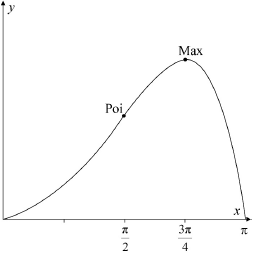
correct shape and correct domain A1
max at \(x = \frac{{3\pi }}{4}\), point of inflexion at \(x = \frac{\pi }{2}\) A1
zeros at \(x = 0\) and \(x = \pi \) A1
Note: Penalize incorrect domain with first A mark; allow FT from (d) on extra points of inflexion.
[3 marks]
EITHER
\(\int_0^x {{{\text{e}}^x}\sin x{\text{d}}x = [{{\text{e}}^x}\sin x]_0^\pi – \int_0^\pi {{{\text{e}}^x}\cos x{\text{d}}x} } \) M1A1
\(\int_0^\pi {{{\text{e}}^x}\sin x{\text{d}}x = [{{\text{e}}^x}\sin x]_0^\pi – \left( {[{{\text{e}}^x}\cos x]_0^x + \int_0^\pi {{{\text{e}}^x}\sin x{\text{d}}x} } \right)} \) A1
OR
\(\int_0^\pi {{{\text{e}}^x}\sin x{\text{d}}x = [ – {{\text{e}}^x}\cos x]_0^\pi + \int_0^\pi {{{\text{e}}^x}\cos x{\text{d}}x} } \) M1A1
\(\int_0^\pi {{{\text{e}}^x}\sin x{\text{d}}x = [ – {{\text{e}}^x}\cos x]} _0^\pi + \left( {[{{\text{e}}^x}\sin x]_0^\pi – \int_0^\pi {{{\text{e}}^x}\sin x{\text{d}}x} } \right)\) A1
THEN
\(\int_0^\pi {{{\text{e}}^x}\sin x{\text{d}}x = \frac{1}{2}\left( {[{{\text{e}}^x}\sin x]_0^x – [{{\text{e}}^x}\cos x]_0^x} \right)} \) M1A1
\(\int_0^\pi {{{\text{e}}^x}\sin x{\text{d}}x = \frac{1}{2}({{\text{e}}^x} + 1)} \) A1
[6 marks]
\(\frac{{{\text{d}}y}}{{{\text{d}}x}} = 0\) (A1)
\(\frac{{{d^2}y}}{{d{x^2}}} = 2{e^{\frac{{3\pi }}{4}}}\cos \frac{{3\pi }}{4} = – \sqrt 2 {e^{\frac{{3\pi }}{4}}}\) (A1)
\(\kappa = \frac{{\left| { – \sqrt 2 {{\text{e}}^{\frac{{3\pi }}{4}}}} \right|}}{1} = \sqrt 2 {{\text{e}}^{\frac{{3\pi }}{4}}}\) A1
[3 marks]
\(\kappa = 0\) A1
the graph is approximated by a straight line R1
[2 marks]
Examiners report
[N/A]
[N/A]
[N/A]
[N/A]
[N/A]
[N/A]
[N/A]
[N/A]
Question
Let \(y = {{\text{e}}^x}\sin x\).
Consider the function \(f\) defined by \(f(x) = {{\text{e}}^x}\sin x,{\text{ }}0 \leqslant x \leqslant \pi \).
The curvature at any point \((x,{\text{ }}y)\) on a graph is defined as \(\kappa = \frac{{\left| {\frac{{{{\text{d}}^2}y}}{{{\text{d}}{x^2}}}} \right|}}{{{{\left( {1 + {{\left( {\frac{{{\text{d}}y}}{{{\text{d}}x}}} \right)}^2}} \right)}^{\frac{3}{2}}}}}\).
Find an expression for \(\frac{{{\text{d}}y}}{{{\text{d}}x}}\).
Show that \(\frac{{{{\text{d}}^2}y}}{{{\text{d}}{x^2}}} = 2{{\text{e}}^x}\cos x\).
Show that the function \(f\) has a local maximum value when \(x = \frac{{3\pi }}{4}\).
Find the \(x\)-coordinate of the point of inflexion of the graph of \(f\).
Sketch the graph of \(f\), clearly indicating the position of the local maximum point, the point of inflexion and the axes intercepts.
Find the area of the region enclosed by the graph of \(f\) and the \(x\)-axis.
The curvature at any point \((x,{\text{ }}y)\) on a graph is defined as \(\kappa = \frac{{\left| {\frac{{{{\text{d}}^2}y}}{{{\text{d}}{x^2}}}} \right|}}{{{{\left( {1 + {{\left( {\frac{{{\text{d}}y}}{{{\text{d}}x}}} \right)}^2}} \right)}^{\frac{3}{2}}}}}\).
Find the value of the curvature of the graph of \(f\) at the local maximum point.
Find the value \(\kappa \) for \(x = \frac{\pi }{2}\) and comment on its meaning with respect to the shape of the graph.
Answer/Explanation
Markscheme
\(\frac{{{\text{d}}y}}{{{\text{d}}x}} = {{\text{e}}^x}\sin x + {{\text{e}}^x}\cos x{\text{ }}\left( { = {{\text{e}}^x}(\sin x + \cos x)} \right)\) M1A1
[2 marks]
\(\frac{{{{\text{d}}^2}y}}{{{\text{d}}{x^2}}} = {{\text{e}}^x}(\sin x + \cos x) + {{\text{e}}^x}(\cos x – \sin x)\) M1A1
\( = 2{{\text{e}}^x}\cos x\) AG
[2 marks]
\(\frac{{{\text{d}}y}}{{{\text{d}}x}} = {{\text{e}}^{\frac{{3\pi }}{4}}}\left( {\sin \frac{{3\pi }}{4} + \cos \frac{{3\pi }}{4}} \right) = 0\) R1
\(\frac{{{{\text{d}}^2}y}}{{{\text{d}}{x^2}}} = 2{{\text{e}}^{\frac{{3\pi }}{4}}}\cos \frac{{3\pi }}{4} < 0\) R1
hence maximum at \(x = \frac{{3\pi }}{4}\) AG
[2 marks]
\(\frac{{{{\text{d}}^2}y}}{{{\text{d}}{x^2}}} = 0 \Rightarrow 2{{\text{e}}^x}\cos x = 0\) M1
\( \Rightarrow x = \frac{\pi }{2}\) A1
Note: Award M1A0 if extra zeros are seen.
[2 marks]

correct shape and correct domain A1
max at \(x = \frac{{3\pi }}{4}\), point of inflexion at \(x = \frac{\pi }{2}\) A1
zeros at \(x = 0\) and \(x = \pi \) A1
Note: Penalize incorrect domain with first A mark; allow FT from (d) on extra points of inflexion.
[3 marks]
EITHER
\(\int_0^x {{{\text{e}}^x}\sin x{\text{d}}x = [{{\text{e}}^x}\sin x]_0^\pi – \int_0^\pi {{{\text{e}}^x}\cos x{\text{d}}x} } \) M1A1
\(\int_0^\pi {{{\text{e}}^x}\sin x{\text{d}}x = [{{\text{e}}^x}\sin x]_0^\pi – \left( {[{{\text{e}}^x}\cos x]_0^x + \int_0^\pi {{{\text{e}}^x}\sin x{\text{d}}x} } \right)} \) A1
OR
\(\int_0^\pi {{{\text{e}}^x}\sin x{\text{d}}x = [ – {{\text{e}}^x}\cos x]_0^\pi + \int_0^\pi {{{\text{e}}^x}\cos x{\text{d}}x} } \) M1A1
\(\int_0^\pi {{{\text{e}}^x}\sin x{\text{d}}x = [ – {{\text{e}}^x}\cos x]} _0^\pi + \left( {[{{\text{e}}^x}\sin x]_0^\pi – \int_0^\pi {{{\text{e}}^x}\sin x{\text{d}}x} } \right)\) A1
THEN
\(\int_0^\pi {{{\text{e}}^x}\sin x{\text{d}}x = \frac{1}{2}\left( {[{{\text{e}}^x}\sin x]_0^x – [{{\text{e}}^x}\cos x]_0^x} \right)} \) M1A1
\(\int_0^\pi {{{\text{e}}^x}\sin x{\text{d}}x = \frac{1}{2}({{\text{e}}^x} + 1)} \) A1
[6 marks]
\(\frac{{{\text{d}}y}}{{{\text{d}}x}} = 0\) (A1)
\(\frac{{{d^2}y}}{{d{x^2}}} = 2{e^{\frac{{3\pi }}{4}}}\cos \frac{{3\pi }}{4} = – \sqrt 2 {e^{\frac{{3\pi }}{4}}}\) (A1)
\(\kappa = \frac{{\left| { – \sqrt 2 {{\text{e}}^{\frac{{3\pi }}{4}}}} \right|}}{1} = \sqrt 2 {{\text{e}}^{\frac{{3\pi }}{4}}}\) A1
[3 marks]
\(\kappa = 0\) A1
the graph is approximated by a straight line R1
[2 marks]
Examiners report
[N/A]
[N/A]
[N/A]
[N/A]
[N/A]
[N/A]
[N/A]
[N/A]
Question
Let \(f\left( x \right) = \frac{{2 – 3{x^5}}}{{2{x^3}}},\,\,x \in \mathbb{R},\,\,x \ne 0\).
The graph of \(y = f\left( x \right)\) has a local maximum at A. Find the coordinates of A.
Show that there is exactly one point of inflexion, B, on the graph of \(y = f\left( x \right)\).
The coordinates of B can be expressed in the form B\(\left( {{2^a},\,b \times {2^{ – 3a}}} \right)\) where a, b\( \in \mathbb{Q}\). Find the value of a and the value of b.
Sketch the graph of \(y = f\left( x \right)\) showing clearly the position of the points A and B.
Answer/Explanation
Markscheme
attempt to differentiate (M1)
\(f’\left( x \right) = – 3{x^{ – 4}} – 3x\) A1
Note: Award M1 for using quotient or product rule award A1 if correct derivative seen even in unsimplified form, for example \(f’\left( x \right) = \frac{{ – 15{x^4} \times 2{x^3} – 6{x^2}\left( {2 – 3{x^5}} \right)}}{{{{\left( {2{x^3}} \right)}^2}}}\).
\( – \frac{3}{{{x^4}}} – 3x = 0\) M1
\( \Rightarrow {x^5} = – 1 \Rightarrow x = – 1\) A1
\({\text{A}}\left( { – 1,\, – \frac{5}{2}} \right)\) A1
[5 marks]
\(f”\left( x \right) = 0\) M1
\(f”\left( x \right) = 12{x^{ – 5}} – 3\left( { = 0} \right)\) A1
Note: Award A1 for correct derivative seen even if not simplified.
\( \Rightarrow x = \sqrt[5]{4}\left( { = {2^{\frac{2}{5}}}} \right)\) A1
hence (at most) one point of inflexion R1
Note: This mark is independent of the two A1 marks above. If they have shown or stated their equation has only one solution this mark can be awarded.
\(f”\left( x \right)\) changes sign at \(x = \sqrt[5]{4}\left( { = {2^{\frac{2}{5}}}} \right)\) R1
so exactly one point of inflexion
[5 marks]
\(x = \sqrt[5]{4} = {2^{\frac{2}{5}}}\left( { \Rightarrow a = \frac{2}{5}} \right)\) A1
\(f\left( {{2^{\frac{2}{5}}}} \right) = \frac{{2 – 3 \times {2^2}}}{{2 \times {2^{\frac{6}{5}}}}} = – 5 \times {2^{ – \frac{6}{5}}}\left( { \Rightarrow b = – 5} \right)\) (M1)A1
Note: Award M1 for the substitution of their value for \(x\) into \(f\left( x \right)\).
[3 marks]
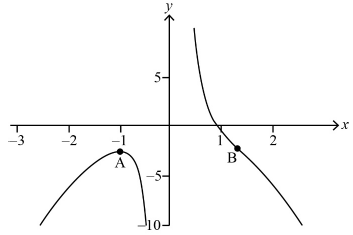 A1A1A1A1
A1A1A1A1
A1 for shape for x < 0
A1 for shape for x > 0
A1 for maximum at A
A1 for POI at B.
Note: Only award last two A1s if A and B are placed in the correct quadrants, allowing for follow through.
[4 marks]
Examiners report
[N/A]
[N/A]
[N/A]
[N/A]
Question
Let \(f\left( x \right) = \frac{{2 – 3{x^5}}}{{2{x^3}}},\,\,x \in \mathbb{R},\,\,x \ne 0\).
The graph of \(y = f\left( x \right)\) has a local maximum at A. Find the coordinates of A.
Show that there is exactly one point of inflexion, B, on the graph of \(y = f\left( x \right)\).
The coordinates of B can be expressed in the form B\(\left( {{2^a},\,b \times {2^{ – 3a}}} \right)\) where a, b\( \in \mathbb{Q}\). Find the value of a and the value of b.
Sketch the graph of \(y = f\left( x \right)\) showing clearly the position of the points A and B.
Answer/Explanation
Markscheme
attempt to differentiate (M1)
\(f’\left( x \right) = – 3{x^{ – 4}} – 3x\) A1
Note: Award M1 for using quotient or product rule award A1 if correct derivative seen even in unsimplified form, for example \(f’\left( x \right) = \frac{{ – 15{x^4} \times 2{x^3} – 6{x^2}\left( {2 – 3{x^5}} \right)}}{{{{\left( {2{x^3}} \right)}^2}}}\).
\( – \frac{3}{{{x^4}}} – 3x = 0\) M1
\( \Rightarrow {x^5} = – 1 \Rightarrow x = – 1\) A1
\({\text{A}}\left( { – 1,\, – \frac{5}{2}} \right)\) A1
[5 marks]
\(f”\left( x \right) = 0\) M1
\(f”\left( x \right) = 12{x^{ – 5}} – 3\left( { = 0} \right)\) A1
Note: Award A1 for correct derivative seen even if not simplified.
\( \Rightarrow x = \sqrt[5]{4}\left( { = {2^{\frac{2}{5}}}} \right)\) A1
hence (at most) one point of inflexion R1
Note: This mark is independent of the two A1 marks above. If they have shown or stated their equation has only one solution this mark can be awarded.
\(f”\left( x \right)\) changes sign at \(x = \sqrt[5]{4}\left( { = {2^{\frac{2}{5}}}} \right)\) R1
so exactly one point of inflexion
[5 marks]
\(x = \sqrt[5]{4} = {2^{\frac{2}{5}}}\left( { \Rightarrow a = \frac{2}{5}} \right)\) A1
\(f\left( {{2^{\frac{2}{5}}}} \right) = \frac{{2 – 3 \times {2^2}}}{{2 \times {2^{\frac{6}{5}}}}} = – 5 \times {2^{ – \frac{6}{5}}}\left( { \Rightarrow b = – 5} \right)\) (M1)A1
Note: Award M1 for the substitution of their value for \(x\) into \(f\left( x \right)\).
[3 marks]
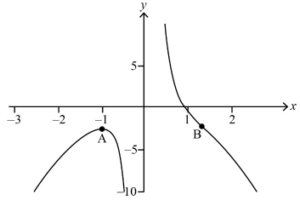 A1A1A1A1
A1A1A1A1
A1 for shape for x < 0
A1 for shape for x > 0
A1 for maximum at A
A1 for POI at B.
Note: Only award last two A1s if A and B are placed in the correct quadrants, allowing for follow through.
[4 marks]
Examiners report
[N/A]
[N/A]
[N/A]
[N/A]
Question
The function f is defined, for \( – \frac{\pi }{2} \leqslant x \leqslant \frac{\pi }{2}\) , by \(f(x) = 2\cos x + x\sin x\) .
Determine whether f is even, odd or neither even nor odd.
Show that \(f”(0) = 0\) .
John states that, because \(f”(0) = 0\) , the graph of f has a point of inflexion at the point (0, 2) . Explain briefly whether John’s statement is correct or not.
Answer/Explanation
Markscheme
\(f( – x) = 2\cos ( – x) + ( – x)\sin ( – x)\) M1
\( = 2\cos x + x\sin x\,\,\,\,\,\left( { = f(x)} \right)\) A1
therefore f is even A1
[3 marks]
\(f'(x) = – 2\sin x + \sin x + x\cos x\,\,\,\,\,( = – \sin x + x\cos x)\) A1
\(f”(x) = – \cos x + \cos x – x\sin x\,\,\,\,\,( = – x\sin x)\) A1
so \(f”(0) = 0\) AG
[2 marks]
John’s statement is incorrect because
either; there is a stationary point at (0, 2) and since f is an even function and therefore symmetrical about the y-axis it must be a maximum or a minimum
or; \(f”(x)\) is even and therefore has the same sign either side of (0, 2) R2
[2 marks]
Examiners report
[N/A]
[N/A]
[N/A]
